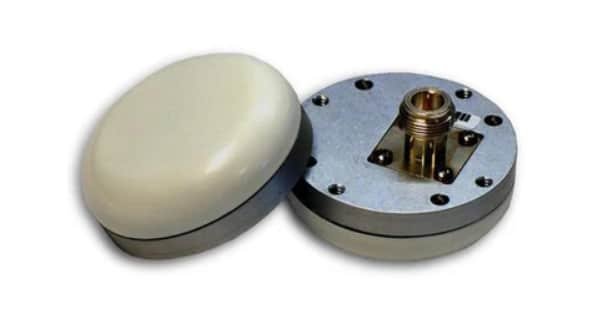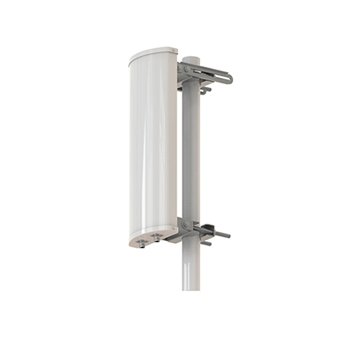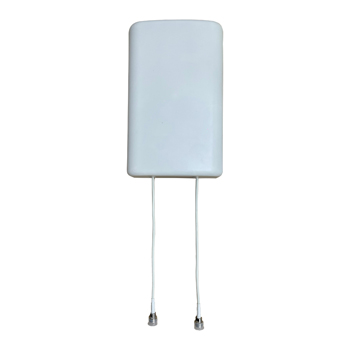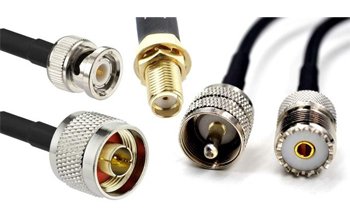
Antennas are a critical component for setting up wireless networks as they transmit and receive signals to ensure seamless communication between devices. Antennas play a major role in the signal strength and coverage of a WiFi system. Basically, WiFi antennas convert the radio frequency electromagnetic waves used by wireless devices into electrical signals and vice versa, thus transferring packets of information between wireless devices. Wireless networking devices like smartphones, laptops, routers have transmitting and receiving antennas for signal radiation and reception. Mainly, WiFi antennas can be categorized into two sections as omnidirectional and directional WiFi antennas. However, the effectiveness of a Wi-Fi antenna isn’t solely determined by the antenna itself, the wifi antenna connectors play a crucial role in ensuring signal stability and quality.
It bridges the gap between devices and the signals in the communication system. An antenna connector is a device designed to link connecting cables with the electronic equipment to enable transmission and receival of signals. An antenna connector is generally found at the end of an antenna and this attachment to the antenna acts as a channel for the transmission of radio frequency signals. This plays a major role in minimizing the signal loss, discontinuity issues, and impedance mismatches. Signal loss usually occurs when there is a mismatch in impedance between the connector and the device or antenna which can lead to weak or distorted signals. Thus it is important to use proper connectors with matching impedance ratings. An antenna connector generally acts as a point of electrical connection as well as mechanical connection since it is usually the single point at which the antenna is connected to the radio frequency device.
There is a wide range of antenna connectors available in the market today. This article discusses a few of the most widely used types of antenna connectors which vary by their physical and electrical profiles.
Table of Contents
ToggleRole of Connectors in WiFi Systems
Antenna connectors create a physical and electrical connection between the antenna and the device or antenna and the cables, thus allowing the device to send or receive signals through the antenna. Antenna connectors are responsible for ensuring a reliable and efficient transfer of signals. The connector of the antenna can improve the overall performance of the antenna. The mechanical and structural properties of antenna connectors are important as well. Depending on how the antenna is mounted, a connector may be part of a hinged, rotating, or recessed arrangement within the antenna. The size and quality of an antenna connector determines how the antenna will be embedded in or installed on a device. This can be an important consideration for applications where there are space limitations. Thus, WiFi antenna connectors play a significant role in terms of electrical connection as well as physical connection in a WiFi system.
Overview of WiFi Antenna Connectors
There are various types of antenna connectors available today. Each type of connector has a different design and structure making them useful for specific applications. It is important to consider the frequency range, power level, and impedance of the device when selecting a connector for a WiFi antenna. Discussed below are some of the most commonly used connectors for WiFi antennas.
1. SMA Connectors
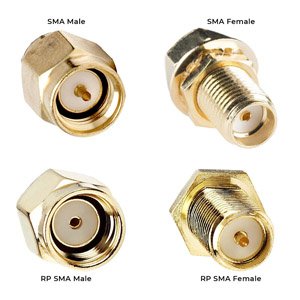
The Sub Miniature Antenna connector is typically used for applications that require high performance antennas such as wireless communication systems and WiFi routers. This type of connector is available in both female and male versions. The male SMA connector has a threaded body and a center pin while the female version has a threaded body and a center hole. Due to the exceptional fit between male and female counterparts of SMA connectors, using both together for an application provides great electrical performance and shielding. SMA connectors are typically used in antennas that have a varying frequency. They can be used with semi-rigid and flexible coaxial antenna cables. They are widely used in cellular networking due to their small size, robustness, and consistent performance at UHF / microwave frequencies. Other common applications include WiFi antennas and GPS antennas. These connectors are found in different orientations such as bulkhead and PCB mountable versions and generally can reliably support frequencies up to 18 GHz.
2. RP-SMA Connector
The Reverse Polarity (RP) SMA connector is similar to SMA connector, but as the name suggests it has reverse gender and reverse threading unlike SMA connectors which have reverse gender but no reverse threading. These are widely used in applications such as WiFi antennas, access points, routers, wireless devices. They are also used in other radio equipment, Bluetooth equipment and other types of antennas such as dipole, Yagi and ground plane antennas. RP-SMA connectors are able to withstand harsh weather conditions and hence can be ideal for setting up secure and reliable signal transmissions through WiFi antennas in outdoor settings. Similar to SMA antenna connectors, these are also available in bulkhead and PCB-mountable versions. Male RP- SMA connectors have an inner socket in place of the center pin in a SMA male connector while the female RP-SMA female connectors have a center pin in place of the inner socket in a SMA connector. Similar to SMA connectors they can reliably support frequencies up to 18 GHz and have similar electrical properties.
3. N-Type Connectors

The N-type connector is a threaded, weatherproof type of antenna connector that can be used even in challenging environmental conditions making them suitable for even outdoor applications. They are typically used for applications such as WiFi antennas, military applications and telecommunication systems.
Considering the physical specifications they usually consist of an inner and outer conductor separated by an air gap. The inner conductor is an inner pin or socket. Typically, these connectors are made using brass with gold or silver plating on the inner contacts with a rubber gasket around it for weatherproofing. In N-type connectors, the male connector carries a center pin and internalized threads while the female connector has an inner receptacle and externalized threading. These connectors typically operate up to 11 GHz but certain variants can extend up to 18 GHz and have impedance levels of 50 Ohms or 75 Ohms. They support a peak voltage of around 1500 Volts at a VSWR of 1.3.
4. TNC Connectors
The Threaded Neill Concelman connector is another commonly used type of connector for WiFi antennas. They are usually made of stainless steel, brass, or copper materials and consist of a threaded coupling nut for secure and durable connection. The TNC connectors are available at impedance levels of 50 Ohms and 75 Ohms generally. Matching impedances will enable to reduce signal reflections and improve the signal to noise ratio. They generally have a peak voltage of around 500 Volts and a VSWR of around 1.35. This type of connectors are used in applications that require quick connecting and disconnecting making them an ideal connector type for temporary installations and applications where there can be slight shocks and vibrations. The female connector generally has externalized threads and a receptacle at the center while the male connector has internalized threads and a brass center pin. There are also weatherproof versions of these connectors available with a silicon outer covering.
5. MCX and MMCX Connectors
Micro-Miniature Coaxial (MMCX) and MCX (Micro Coaxial) connectors are antenna connector types used for RF connections. They are generally small in size and light weight with a low-profile design making them ideal for applications with space restrictions. They can easily fit into circuit boards. These connector types are usually made from brass with gold or copper-plated inner conductors. The male connectors have a center pin while the female connectors have a socket, both which are separated by the external conductor using a PTFE dielectric. MCX and MMCX antenna connectors are easy to install and offer reliable, robust, secure, and durable connections with the antennas. These connectors are used widely in antenna applications including WiFi antennas. They are also ideal for antenna deployments in remote locations as they can be assembled easily and securely along with their quick connect/disconnect capabilities. These connectors are also suitable for outdoor applications as they can perform reliably even in harsh environment conditions. MMCX and MCX connectors can typically handle frequencies of up to 6 GHz. They generally perform at an impedance level of 50 Ohms, a peak voltage of 170 V, and a VSWR of about 1.25. They are designed to be used with small, flexible coaxial cables.
6. U.FL and IPEX Connectors
The U.FL connector is a commonly used antenna connector for various applications. They are small in size which allows them to be used in applications with limited space such as PCBs. They are generally used in applications such as WiFi antennas, Bluetooth and other radio frequency antenna components. They are also extremely useful in compact devices like phones and laptops. U.FL connectors consist of phosphor bronze shell, a liquid crystal polymer insulator and a brass or bronze center conductor. The male connectors generally have the center pin while the female connectors have the central receptor. These can generally support up to 6 GHz operating frequencies and operate in an impedance level of 50 Ohms. Their typical peak operating voltage is about 200 Volts with a VSWR of around 1.35. But they cannot be easily connected and disconnected like MCX or MCCX antennas.
I-PEX antenna connectors are surface mount small RF connectors which can be used as an alternative to U.FL connectors. These connectors can operate at frequencies up to 6 GHz but some can even extend up to 9 GHz. They generally have an impedance level of 50 ohms. IPEX connectors are generally used for WiFi antennas as well as applications such as smartphones, laptops, and embedded systems.
7. TS9 connector
TS-9 antenna connector is a small device with 3.5 mm inner diameter and 3.8 mm outer diameter typically and is used mostly in compact PCB environments. They are generally used in applications such as WiFi antenna systems, mobile phones and handheld radio antennas, external antennas for cellular data applications, USB wireless dongles etc. TS9 connectors generally consist of a gold or nickel plated circular barrel and a pin at the end of the threaded slot. They are available in straight and right angled versions for both female and male connectors. TS9 antennas generally have a normal impedance of 50 Ohms or 75 Ohms and operate at frequencies up to 3 GHz. The peak voltage reached is generally around 100 Volts with a VSWR of 1.3. These TS9 connectors are ideal for applications that require mobility.
Cable Considerations
The performance of an electronic or communication system is dependent on multiple factors. However, cables can be defined as one of the unsung heroes of such a system as they play a key role in making the transmission and receival of signals seamless. Proper selection of cables and connectors is crucial to ensure optimal performance and reliability. The cables can make a significant difference in the overall performance of an antenna connector and ultimately on the entire system.
One of the key factors to consider regarding a cable is the construction material of the cable. Using quality copper cables can be highly effective as they have excellent conductivity, durability, and affordability. Signal transmission between the antenna and antenna connector can be significantly improved and losses and interference can be minimized with cables made using quality material.
Another important aspect to consider regarding the quality of the cable is the manufacturing process. The ability to maintain stable signal transmission and receival reliably can be dependent on proper manufacturing of the cables. The ability to withstand external environmental impacts such as temperature and humidity will be determined based on the tests done during the manufacturing process. High quality cables that have undergone such vigorous testing will ensure that minimal losses will occur during signal or data transmission between the cable and antenna connectors.
Overall, the quality of the cables can have a massive impact on the performance and reliability of an antenna connector as well as the entire communication system. A well-manufactured, quality cable will ensure optimal signal transfer rates with minimal losses, minimal dropped connections or downtime, and reduced system failures. Investing in high-quality cables will be beneficial to achieve optimal performance in antenna connectors and WiFi systems. Thus, when selecting cables, it is important to take into consideration high-quality materials, robust construction, and thorough testing of the cables.
Conclusion
This article provided a comprehensive overview of WiFi antenna connectors. As discussed throughout, the connector plays a significant role in enhancing the performance of a WiFi antenna by effectively carrying out the transmission and receival of signals between the cables, connector, antenna and connecting devices. It is crucial to select a suitable antenna connector as it can help in minimizing signal losses, downtime, interferences, and system failures.
In this article, we discussed a brief outlook into the importance of the antenna connector and cables while discussing few of the most commonly used WiFi antenna connectors. With proper understanding of the available antenna connector types and their performance characteristics, it is possible to select a suitable connector such that the optimal performance of the communication system can be achieved.

